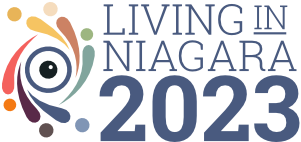Low Income Measure in Niagara
The following table is from the Niagara Region Housing and Homelessness Action Plan (HHAP) Technical Report
Table: 2.1 2010 Low Income Measure
|
Number of persons in household |
Low Income Measure |
|
One person |
22,160 |
|
Two persons |
31,339 |
|
Three persons |
38,382 |
|
Four persons |
44,320 |
|
Five persons |
49,551 |
|
Six persons |
54,281 |
|
Seven or more persons |
58,630 |
Source: Statistics Canada, Low Income Measure before Tax 2010
Statistics Canada defines low income measure as “a fixed percentage (50 per cent) of median adjusted total income of households observed at the person level, where ‘adjusted’ indicates that a household’s needs are taken into account”.
In 2012 the percentage of the population living below the Low Income Measure before taxes was: 17.6 per cent (roughly 67,840 persons). Source: Statistics Canada, CANSIM 111-0015
Source: Niagara Region HHAP Technical Report
Retrieved From: http://www.niagararegion.ca/social-services/technical-report/affordability-report.aspx
Income Levels in Niagara
The following statistics are from the Niagara Region Housing and Homelessness Action Plan (HHAP) Technical Report
Household Income
1.8 Median Income in Niagara and Ontario, 2012

Source: Statistics Canada, 2012 Canada Revenue Agency Tax Filer Data
Across all household types the median income is lower in Niagara ($68,410) than the provincial median ($74,890). Persons in non-census families (such as one-person households) in Niagara have the lowest median incomes at $25,820. While couple families have a higher household income these higher occupancy households have greater expenses.
Source: Niagara Region HHAP Technical Report
Retrieved From: http://www.niagararegion.ca/social-services/technical-report/demographics-report.aspx
The following table shows income data from the Statistics Canada 2011 National Household Survey for the St. Catharines-Niagara CMA (census metropolitan area).
Note: this CMA does not include Grimsby and West Lincoln; and, the 2011 NHS for this CMA had a global non-response rate of over 25%.

Source: Statistics Canada National Household Survey (2011)
Retrieved From: http://www12.statcan.gc.ca/nhs-enm/2011/as-sa/fogs-spg/Pages/FOG.cfm?lang=E&level=3&GeoCode=539
Being Poor in West Niagara Report
This report, published September, 2013 by Community Care of West Niagara (CCWN) provides facts and figures to show that, as CCWN clients are spending an exceptionally high proportion of their income on housing, the cost of healthy eating is becoming increasingly out of reach for many.
Clients served by CCWN come from all walks of life and have experienced financial difficulties due to job loss, illness or other hardships. CCWN is a registered charitable non-profit organization located in Beamsville in the Town of Lincoln, and has served West Niagara since 1967. CCWN’s mission is to provide a bridge between dependency and self-sufficiency for people to support themselves and their families with dignity and purpose.
Source: Community Care of West Niagara
Retrieved From: http://www.niagaraknowledgeexchange.com/wp-content/uploads/sites/2/2014/10/Being_Poor_in_West_Niagara_September_2013.pdf
Market Basket Measure (MBM)
The MBM is a measure of low income based on the cost of a specific basket of goods and services representing a modest, basic standard of living. It includes the costs of food, clothing, footwear, transportation, shelter and other expenses for a reference family of two adults aged 25-49 and two children (aged 9 and 13).

Source: Statistics Canada
Retrieved From: http://www.statcan.gc.ca/pub/75f0002m/75f0002m2012002-eng.pdf
The Nutritious Food Basket
The Nutritious Food Basket is a tool that assesses the current costs of nutritious foods that families often buy, not including personal and household care items.
Registered Dietitians at Niagara Region Public Health have been collecting this information since 1998 and it’s used to raise awareness about the cost of healthy eating and to assess the sustainability of social assistance and minimum wages.
The cost of healthy eating in 2013 for a family of four in the Niagara region is $190.15 per week. This is based on a mother and father (both aged 31 – 50), daughter (aged 4 – 8) and son (aged 14 – 18).
On a monthly basis, this family would spend $823.35 on nutritious food.
The cost of healthy eating in Niagara has increased over two per cent between 2012 and 2013.
Source: Niagara Region Public Health
Retrieved From: http://www.niagararegion.ca/living/health_wellness/healthyeating/hungry/cost-healthy-eating.aspx
Food Security, Food Bank Use and Hunger Count in Niagara
In 2012, a total of 12,107 individuals were served at Niagara food banks. This amount has grown by 38 per cent since 2008. A total of 36 per cent of these individuals were children.4
The majority of individuals who accessed food banks in Niagara were on social assistance or ODSP. A total of 78 per cent of individuals served at Niagara food banks were renting their home.4
4. Food Banks Canada. Hunger Count data (2012). Food bank usage in Niagara region.

Source: Niagara Region
Retrieved From: http://www.niagararegion.ca/living/health_wellness/healthyeating/hungry/testimonials/hunger-information.aspx
The 2014 Hunger Count Report from Food Banks Canada reported that in March, 2014, 374,698 people were helped by food banks in Ontario. This number is up 19.2% since 2008. A total of 35% of the people being helped were children.
Source: Food Banks Canada
Retrieved From: http://www.niagaraknowledgeexchange.com/resources-publications/hunger-count-2014/
2013 Ontario Hunger Count stats/Food Banks Canada

Source: 2013 Hunger Count Report
Retrieved From: http://www.foodbankscanada.ca/getmedia/335e9c34-11cc-4822-ab3c-2038fc72bf08/HungerCount-Ontario-2012-Report–FINAL.pdf.aspx?ext=.pdf
Social Assistance in Niagara
The following information is from Niagara Region Community Services
2.1a Niagara Social Assistance Data: Ontario Works

2.1b Niagara Social Assistance Data: Employment Insurance

Sources: Niagara Region Community Services, Social Assistance and Employment Opportunities; Statistics Canada, Tax Filer Data
Chart 2.1a shows average Ontario Works caseloads and 2.1b shows the number of Employment Insurance recipients in Niagara from 2003 to the year-end of the most recent data year available. The peak of Employment Insurance recipients occurred in 2009 during the economic downturn, but the trend since 2010 has seen the number of recipients decreasing each year. On the other hand, the number of Ontario Works cases has continued to rise despite improved economic conditions after 2009. These trends may be in part due to Employment Insurance benefits being exhausted (usually within less than a year) and if the individual is unable to find work, they access social assistance such as Ontario Works and remain on the caseload until they can exit to employment.
2.2 Niagara Social Assistance Data – Ontario Disability Support Program

Sources: Niagara Region Community Services
Chart 2.2 shows the average Ontario Disability Support Program caseload in Niagara from 2003 to 2013. The Ontario Disability Support Program caseload has increased each year since 2003 and it is expected this trend will continue in the near term given local economic conditions and the sustained efforts of the Ontario Works office to facilitate Ontario Disability Support Program applications for disabled individuals.
Source: Niagara Region HHAP Technical Report
Retrieved From: http://www.niagararegion.ca/social-services/technical-report/affordability-report.aspx
Economic Deprivation Index in Niagara
Economic Deprivation Ratio – 2008 – CIHI Data Brief, Exploring Urban Environments and Inequalities in Health
Since its creation in the late 1990s, the Québec index of material and social deprivation (INSPQ Deprivation Index) has been widely utilized in the field of public health for purposes that range from
health monitoring and policy development to evaluation of services and resource allocation. More recently, a Canadian version of the index has been produced and used at that level. The deprivation index can be used to track social and health inequalities over time and space.
While this 2008 resource is somewhat dated, it does show how application of the deprivation index can illustrate incidence of material and social deprivation at the neighbourhood level in Niagara.
Source: Canadian Institute of Health Information (CIHI)
Retrieved From: http://www.cihi.ca/CIHI-ext-portal/pdf/internet/PDF_DATABRIEF_STCATHARINES_EN
Further information about work being done to develop the Deprivation Index for Canada is found in this 2012 article published in the Canadian Public Health Association Journal: An Area-based Material and Social Deprivation Index for Public Health in Québec and Canada.
The Deprivation Index is described as: “a state of observable and demonstrable disadvantage relative to local community or the wider society or nation to which the individual, family or group belongs. Material deprivation refers to lack of access to everyday goods and amenities (eg. proper housing, a car or television) and social deprivation refers to the fragility of social networks, from family to community.”
Source: CPHA Journal
Retrieved From: http://journal.cpha.ca/index.php/cjph/article/viewFile/3156/2663
The Number of Personal and Business Bankruptcies in Niagara
2013 Personal Ontario Bankruptcy Statistics
According to statistics released by the Office of the Superintendent of Bankruptcy, the personal bankruptcy rate in Ontario decreased in 2013. What is more impressive is that more than half of all Ontario insolvency filings are now consumer proposals. More and more Ontarians are finding a consumer proposal as a viable alternative to settling their debt problems while avoiding bankruptcy.
|
Major Ontario Cities as reported by the OSB |
2013 |
Growth |
Bankruptcies |
Proposals |
|
Barrie |
921 |
-14.1% |
463 |
458 |
|
Brantford |
508 |
-15.1% |
251 |
257 |
|
Guelph |
371 |
-5.6% |
206 |
165 |
|
Hamilton |
2,497 |
-11.2% |
1,136 |
1,361 |
|
Kingston |
492 |
-8.4% |
319 |
173 |
|
Kitchener and Cambridge |
1,543 |
-5.9% |
795 |
748 |
|
London |
2,067 |
-8.3% |
1,190 |
877 |
|
Oshawa |
1,441 |
-9.0% |
550 |
891 |
|
St. Catharines and Niagara |
1,683 |
12.6% |
845 |
838 |
|
Toronto (GTA) |
16,371 |
-9.2% |
6,714 |
9,657 |
|
Thunder Bay |
293 |
-20.8% |
203 |
90 |
|
Windsor |
1,322 |
-4.8% |
794 |
528 |
|
Ontario |
44,134 |
-6.9% |
21,773 |
22,361 |
|
Canada |
118,678 |
0.2% |
69,224 |
49,454 |
Source: Bankruptcy Ontario
Retrieved From: http://bankruptcy-ontario.org/bankruptcy-in-ontario/bankruptcy-statistics/
Business Bankruptcies
Business insolvency cases for 2012 for the Niagara/Hamilton area are available from the Office of the Superintendent of Bankruptcy Canada, Industry Canada,Insolvency Statistics in Canada—2012 (Table 6).
The following table is based on specific Information from:
Table 6: Insolvencies Filed by Businesses by Economic Region

Source: Office of the Superintendent of Bankruptcy Canada, Industry Canada
Retrieved From: http://www.ic.gc.ca/eic/site/bsf-osb.nsf/eng/br03083.html







